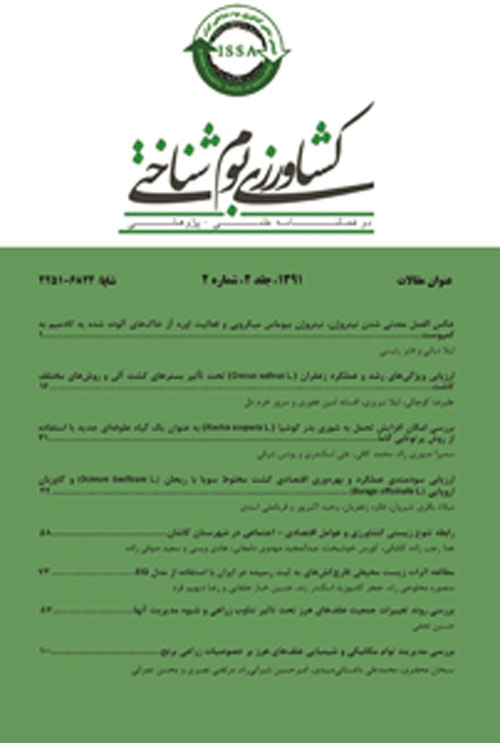The effect of perturbation on the population equilibrium of the carob moth (Apomyelois ceratoniae) in natural conditions
Author(s):
Abstract:
Introduction
The carob moth, Apomyelois ceratoniae, is the chief pest of the pomegranate. Its control is only plausible using ecological pest management. Population dynamics and, in particular, population regulation is of prime importance in ecology. Different factors, including indigenous (intraspecific competition) and exogenous (climate and other organisms), may affect population size; the effects can be dependent or independent of population density (Price, 1997). In general, insect populations can go through equilibrium dynamics or non-equilibrium dynamics. In addition, a population at equilibrium level can be stable, unstable or have neutral stability. Stability denotes a return to the previous equilibrium level after a perturbation. Neutral stability, however, is a shift of the equilibrium to a new level (Cappuccino and Price, 1995; Schowalter, 2012). In the present study, the stability of the population equilibrium of the carob moth was examined.Materials And Methods
To examine the effects of perturbation and the stability of population equilibrium of carob moths, two different experiments were performed. The first experiment included three treatments (perturbation using density reduction, perturbation using density increase, and no perturbation or the control). In the second experiment, only two treatments (perturbation using density reduction and the control) were carried out. All treatments were replicated four times using a randomized complete block design. The growth season was divided equally into two periods, and the number of infested fruits in 30 randomly selected trees per plot (orchard) was recorded weekly for each period. Data were analyzed using log-linear models to determine whether the equilibrium was stable, or if there were any shifts in the equilibrium level.Results And Discussion
The results showed that when there was no perturbation, the equilibrium was unchanged. It was the same for perturbation using density reduction in the first experiment, since the equilibrium showed stability. However, perturbation using density reduction in the second experiment shifted population equilibrium to a lower level. In addition, perturbation using density increase also caused a change in population equilibrium such that the mean infestation of the pre-perturbation period was significantly greater than that for the post-perturbation period.Our findings indicate that creating a perturbation in the population of carob moths may significantly change the stability and population equilibrium as seen in the first experiment with perturbation using density increase. In this experiment, the equilibrium shifted to a higher level after a perturbation. Moreover, in the second experiment with perturbation using density reduction, the perturbation decreased population equilibrium, indicating a neutral stability. When there was no perturbation, carob moth populations showed persistence in a stable manner, where the same equilibrium was recorded for both time periods. It can be said that populations that were not subjected to a perturbation may persist if there are enough food resources. Therefore, these populations cannot be easily perturbed or made unstable by climate or natural enemies unless the populations are manipulated by human practices such as pest management strategies.Conclusion
It was concluded that by using a perturbation, carob moth populations can be ecologically managed. With exact times and applications of ecological strategies of pest management (such as perturbation), it is possible to benefit from the method by lowering population equilibrium to below the economic injury level. Thus, the lowered level of population equilibrium is very important due to its stability, preventing usage of extra pest management practices.Keywords:
Language:
Persian
Published:
Journal of Agroecology, Volume:7 Issue: 1, 2017
Page:
69
magiran.com/p1733910
دانلود و مطالعه متن این مقاله با یکی از روشهای زیر امکان پذیر است:
اشتراک شخصی
با عضویت و پرداخت آنلاین حق اشتراک یکساله به مبلغ 1,390,000ريال میتوانید 70 عنوان مطلب دانلود کنید!
اشتراک سازمانی
به کتابخانه دانشگاه یا محل کار خود پیشنهاد کنید تا اشتراک سازمانی این پایگاه را برای دسترسی نامحدود همه کاربران به متن مطالب تهیه نمایند!
توجه!
- حق عضویت دریافتی صرف حمایت از نشریات عضو و نگهداری، تکمیل و توسعه مگیران میشود.
- پرداخت حق اشتراک و دانلود مقالات اجازه بازنشر آن در سایر رسانههای چاپی و دیجیتال را به کاربر نمیدهد.
دسترسی سراسری کاربران دانشگاه پیام نور!
اعضای هیئت علمی و دانشجویان دانشگاه پیام نور در سراسر کشور، در صورت ثبت نام با ایمیل دانشگاهی، تا پایان فروردین ماه 1403 به مقالات سایت دسترسی خواهند داشت!
In order to view content subscription is required
Personal subscription
Subscribe magiran.com for 70 € euros via PayPal and download 70 articles during a year.
Organization subscription
Please contact us to subscribe your university or library for unlimited access!


